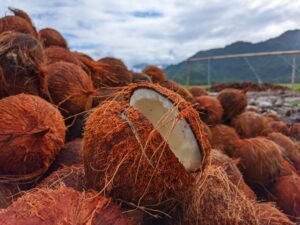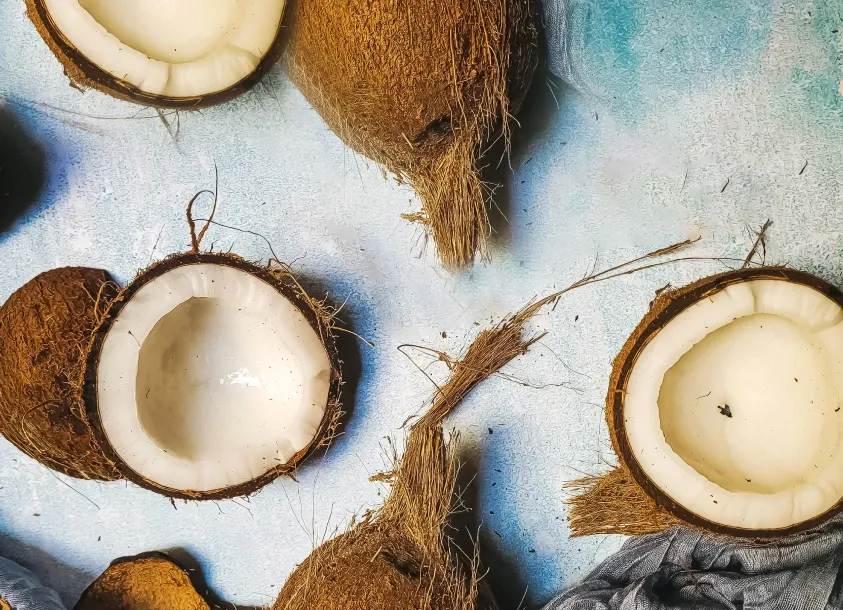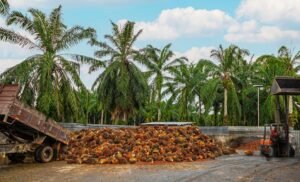
Seasonal Trends in Coconut Supply:
What Buyers Should Know

Understanding the Coconut Supply Cycle in India
India is a major supplier in the international coconut trade, and the coconut byproducts are needed for food, cosmetics, and packaging, as well as religious purposes. Importers looking to bulk source at the right moment need to know how seasonality influences the availability, quality, and pricing of Indian coconuts. India is amongst the highest exporting coconut countries worldwide; hence coconut supply is dependent on local harvest cycles and variation in local climate. The supply cycle has predictable peaks, but the cycle is dependent on rainfall, temperature, and humidity.
In Tamil Nadu and Karnataka, where irrigation is more stable, farmers have been able to operate under a year-round production schedule, obtaining significant yields from February to May and from September to December. Kerala’s agriculture is dependent on the monsoon, and therefore, the principal crop is harvested after the monsoon, between October and December.
In Tamil Nadu and Karnataka, where irrigation is more stable, farmers have been able to operate under a year-round production schedule, obtaining significant yields from February to May and from September to December. Kerala’s agriculture is dependent on the monsoon, and therefore, the principal crop is harvested after the monsoon, between October and December.
Peak and Lean Seasons for Coconut Supply
Timing matters when sourcing coconuts in bulk. Identifying peak and lean seasons helps in forecasting volume and planning container loads efficiently.
- High-Yield Months: February to May and September to December are the two main harvest windows. During these months, supply is at its highest, and exporters can offer better quality and rates.
- Low-Yield Months: June to August often sees a supply dip, especially in Kerala, due to heavy rains and limited harvesting. January is another lean month for certain zones.
- Impact on Logistics: During peak months, exporters can schedule faster turnaround times. During off-peak periods, buyers may face longer loading durations and higher prices due to lower availability.
These states are not only agriculturally rich but also strategically located close to export ports like Chennai, Cochin, and New Mangalore, enabling faster turnaround times for large orders.
How Seasonality Affects Coconut Pricing
Coconut pricing trends closely mirror the supply volumes throughout the year. During peak seasons, when production is high, wholesale coconut prices tend to be lower, offering importers better deals on full-container loads. Conversely, during lean months, demand often exceeds supply, especially from regions like the Middle East and Southeast Asia, where seasonal coconut demand spikes during festivals or Ramadan.
Price variations are also influenced by freight rates and port congestion. For example, exports during festival seasons often attract higher shipping charges and require advanced planning. Indian coconut exporters frequently advise buyers to secure CIF (Cost, Insurance, and Freight) quotes ahead of the seasonal demand curve.
Price variations are also influenced by freight rates and port congestion. For example, exports during festival seasons often attract higher shipping charges and require advanced planning. Indian coconut exporters frequently advise buyers to secure CIF (Cost, Insurance, and Freight) quotes ahead of the seasonal demand curve.
Quality and Shelf Life Depend on Seasonal Conditions
Coconut prices follow the supply in a similar manner during the year. Wholesale coconut prices are lower during high production seasons, which allows importers to find better prices for full-container loads. On the other hand, high season asks for more products than are available in months of lean production, particularly in the Middle East and Southeast Asia, where demand is also higher for coconuts during certain festivals/periods like Ramadan.
Freight rates and port congestion are other drivers of price variations. Exports also have a higher shipping cost and need more planning in festival times, for instance. Indian coconut exporters also often suggest to their buyers to request CIF quotes ahead of the seasonal demand curve.
Freight rates and port congestion are other drivers of price variations. Exports also have a higher shipping cost and need more planning in festival times, for instance. Indian coconut exporters also often suggest to their buyers to request CIF quotes ahead of the seasonal demand curve.
Planning Bulk Coconut Sourcing Around Seasons
Bulk coconut sourcing becomes more effective when aligned with India’s coconut export calendar. International buyers planning to import during festive demand or industrial peak production cycles should consider:
- Booking at least 4 weeks ahead of high-demand seasons
- Coordinating with exporters during harvest months for better prices
- Choosing shipping ports (Chennai, Cochin, Tuticorin) with proximity to producing regions
- Monitoring domestic festivals like Pongal, Onam, and Diwali, which can influence availability
These strategies help minimize delays, reduce costs, and ensure high-volume supply continuity.
Seasonality Shapes Coconut Trade Success
Importers are able to gain a competitive advantage simply by knowing the coconut supply patterns in India. Global buyers can maximize cost, freshness, and reliability by planning purchases according to harvest seasons. As the coconut industry gets increased global significance, matching procurement cycles with the Indian coconut export calendar will be a critical aspect of successful trade relations.
Due to the different climate zones in the country, coconuts are available year-round, although higher volumes may be harvested in some months. For global buyers, this information is pertinent in planning purchases, pricing, and quality control when shipping.
Due to the different climate zones in the country, coconuts are available year-round, although higher volumes may be harvested in some months. For global buyers, this information is pertinent in planning purchases, pricing, and quality control when shipping.
Lorem ipsum dolor sit amet consectetur.
Lorem ipsum dolor sit amet consectetur. Consequat vulputate convallis eget mollis viverra nunc mi egestas. Risus facilisi nullam donec.


